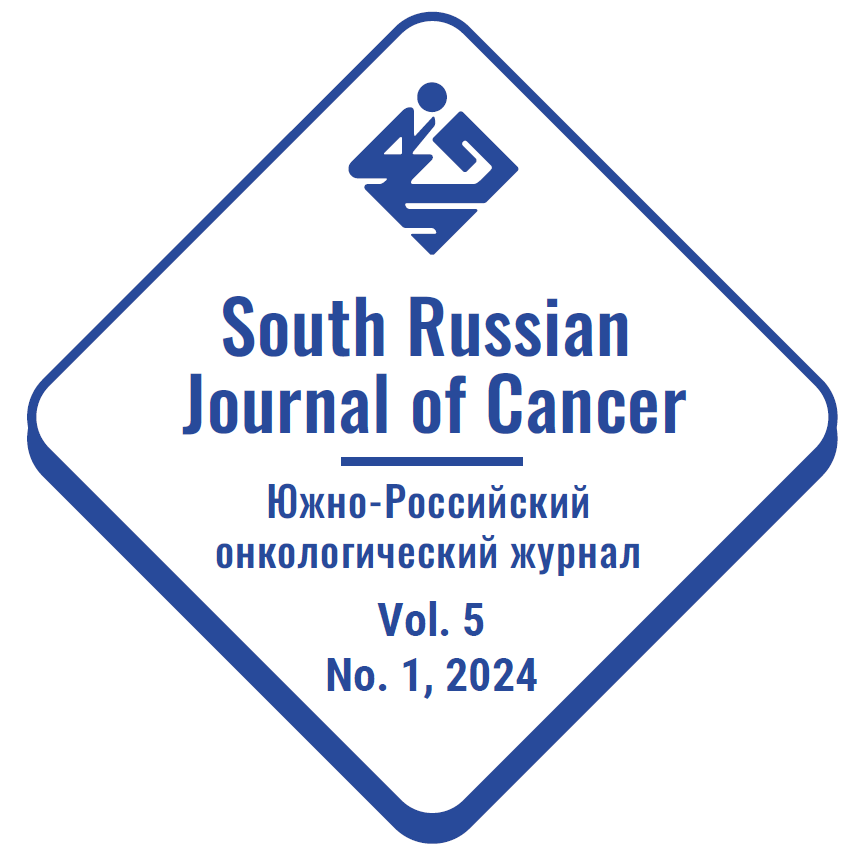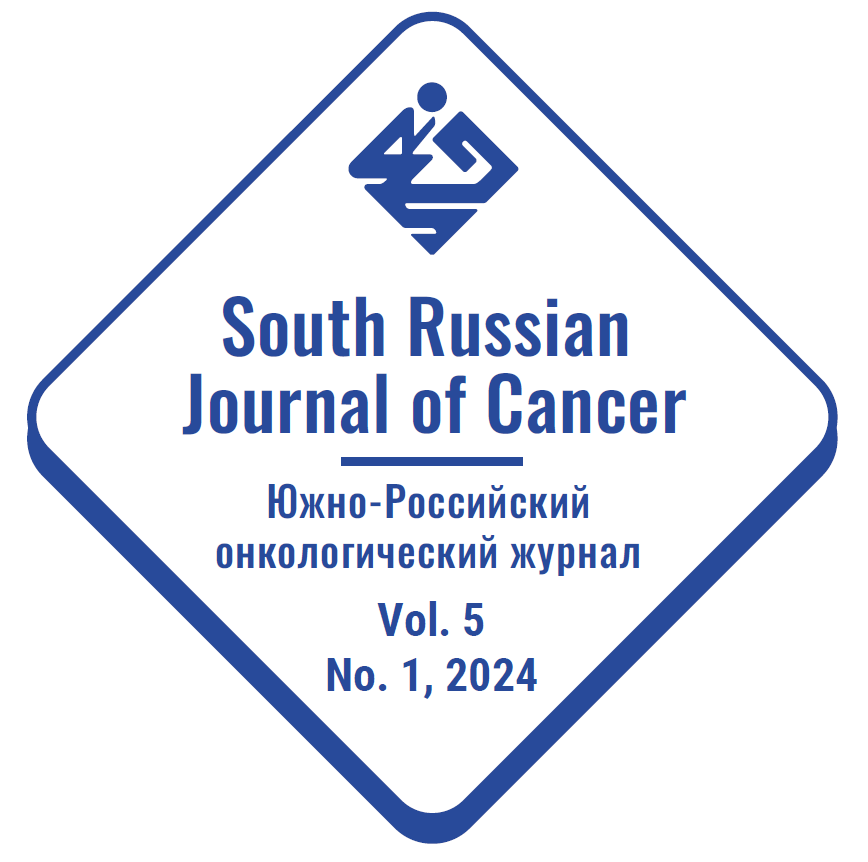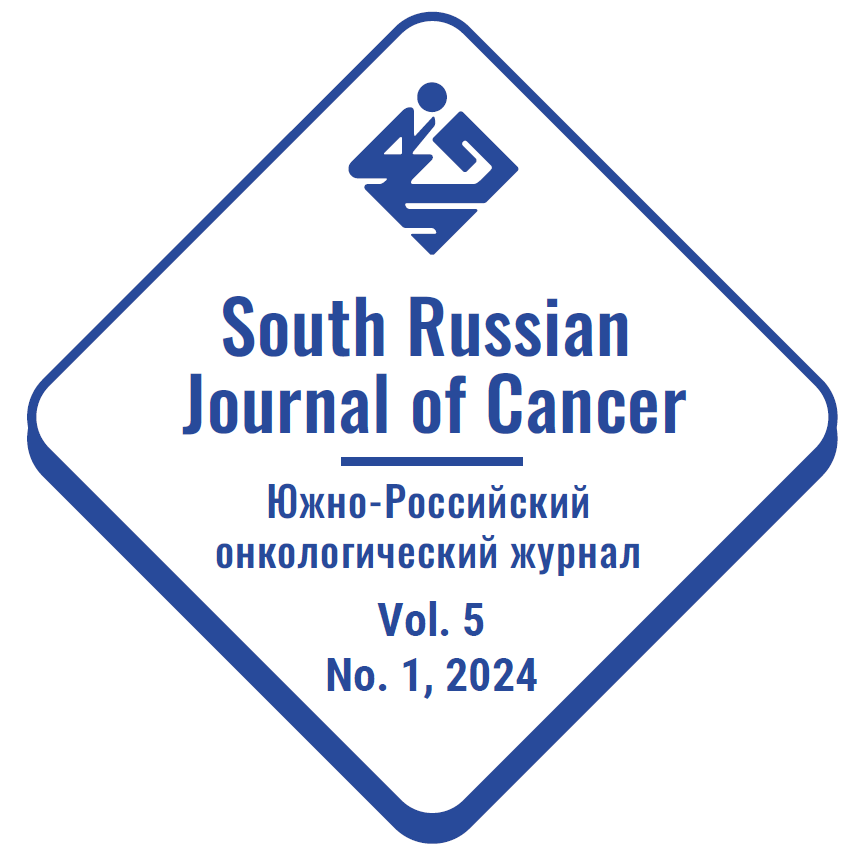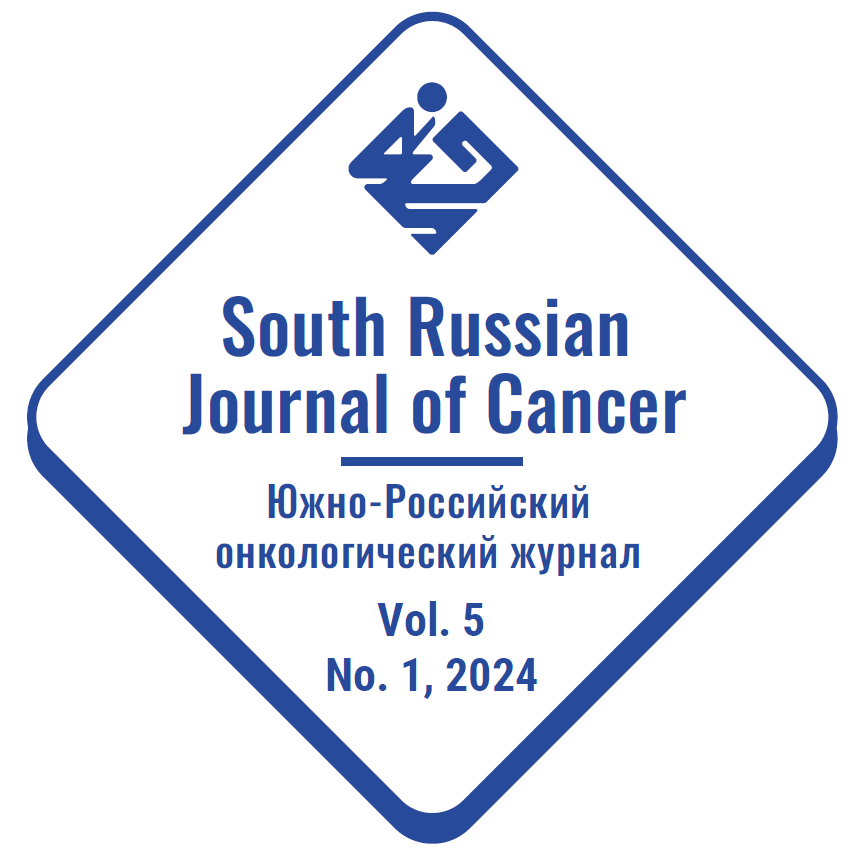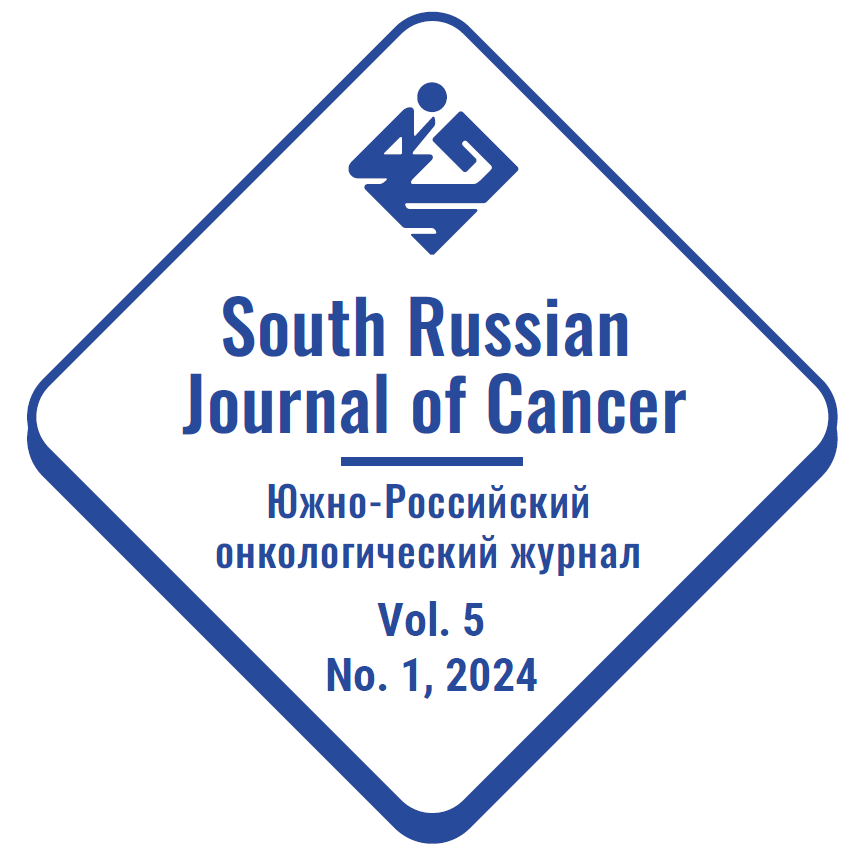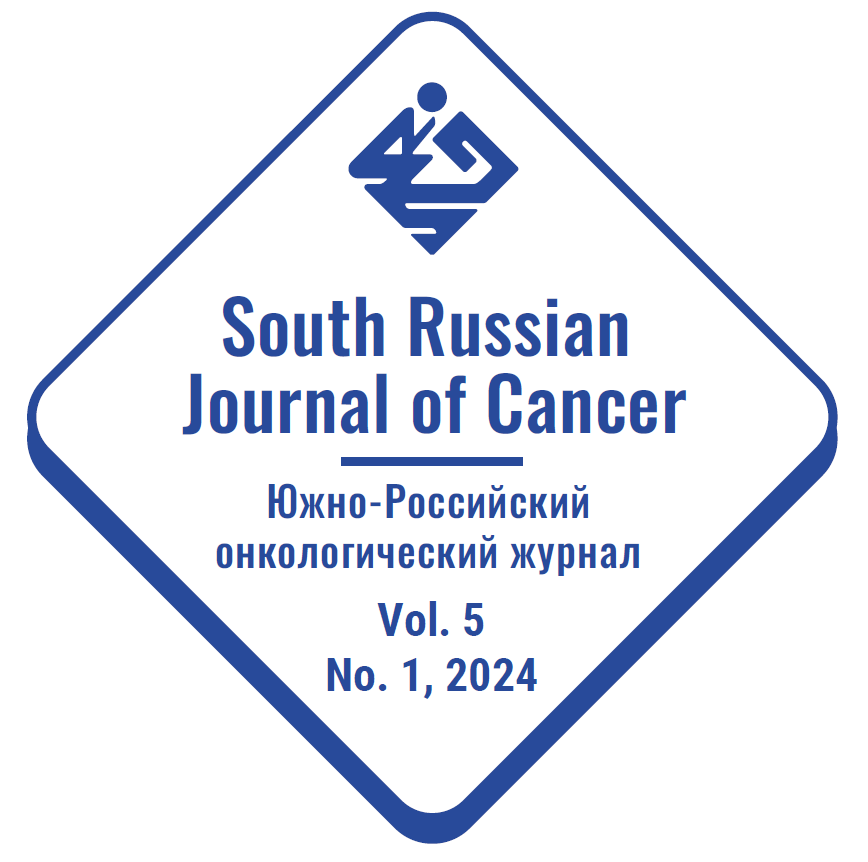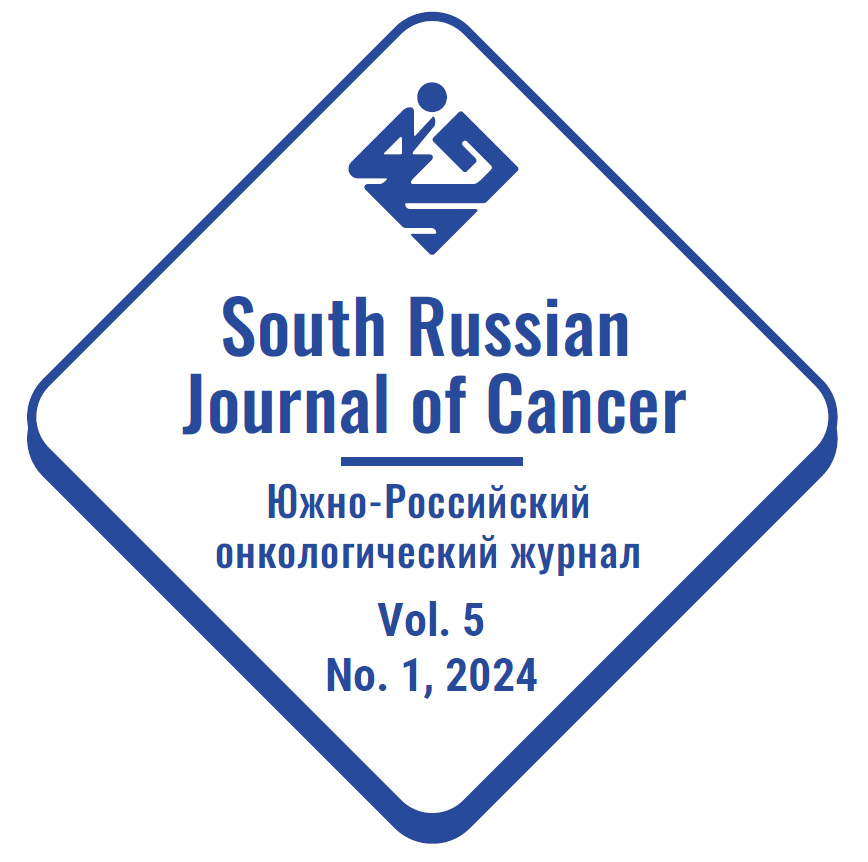ORIGINAL ARTICLES
Purpose of the study. Determination of pathogenetic substantiation and indication criteria for the inclusion of extracorporeal detoxification methods in preoperative preparation of patients with non-small cell lung cancer (NSCLC) complicated by inflammation.
Patients and methods. This study included the data on 222 patients with newly diagnosed stage I–IV NSCLC referred for elective surgical treatment to the Department of Thoracic Oncology, National Medical Centre for Oncology, in 2017–2019. Endogenous intoxication was evaluated in all patients depending on the leukogram results: leukocytic intoxication index (LII), body resistance index (BRI), reactive neutrophil response (RNR), and neutrophil-lymphocyte ratio (NLR). Indicators of the inflammatory response, i. e. interleukin 6 and procalcitonin, were also studied.
Results. 36.5 % of NSCLC patients developed inflammation. That over 70 % of the NSCLC patients showed pronounced clinical and laboratory signs of endogenous intoxication and inhibited protective systems of homeostasis. Initial sub- or decompensated endotoxicosis together with reduced overall reactivity of the body poses a high risk of systemic inflammatory response to antitumor surgical treatment. This justifies the inclusion of extracorporeal detoxification into preoperative preparation of this category of patients as an active preoperative therapy.
Conclusions. Simultaneous elevation of LII, RNR and NLR characterizing the presence of endotoxicosis in sub- and decompensation of endogenous intoxication by own physiological detoxification systems requires an active preoperative preparation with extracorporeal detoxification.
Purpose of the study. Determination of the expression of microRNA‑34, microRNA‑130, microRNA‑148, microRNA‑181, microRNA‑194 and microRNA‑605 in colon tumor tissue depending on the clinical and morphological features of the tumor and the effectiveness of treatment.
Materials and methods. The study included 56 patients diagnosed with colorectal cancer aged 43 to 75 years with the average age of 54 years. Taking into account the local prevalence of the process patients received surgical or combined treatment, including neoadjuvant chemotherapy, in the clinics of the Cancer Research Institute, Tomsk NRMC. MicroRNA expression was determined by polymerase chain reaction (PCR) in real time.
Results. The obtained information revealed the relation of microRNA‑130 to the tumor size. The development of regional metastases was associated with changes in microRNA‑130, microRNA‑194 and microRNA‑605. The level of histological organization of the tumor was associated with microRNA‑34, microRNA‑130, microRNA‑148, and the response to therapy – with microRNA‑130, microRNA‑148 and microRNA‑605. In addition, according to the study, the significance of microRNA‑130 was revealed, which is associated with tumor spread, histological differentiation and response to antitumor therapy.
Conclusion. The features of expression of microRNA‑34, microRNA‑130, microRNA‑148, microRNA‑181, microRNA‑194 and microRNA‑605 associated with clinical and morphological features of colon tumors were revealed. Correlations between the studied indicators are noted, which probably determine the outcome and prognosis of the disease.
Purpose of the study. This work was to assess the engraftment and growth dynamics of breast cancer xenografts during orthotopic and subcutaneous injection using various types of biological material, as well as to develop an adequate model of breast cancer for further research.
Materials and methods. We used a disaggregated fragment of a tumor obtained from the patient, a certified breast cancer cell line VT20 – human breast carcinoma; a primary human breast carcinoma cell line. Female immunodeficient mice of the Balb/c Nude line in the amount of 36 animals were used as recipient animals. The subcutaneous and orthotopic models of breast cancer were developed in this project. Tumor growth was observed for 28 days from the moment of injection and tumor nodes were measured 2 times a week until the end of the experiment. Results were assessed using medians and percentiles. The nonparametric Mann-Whitney test was used to assess the significance of differences.
Results. The dynamics of the growth of tumor cells when injected into various sites was determined in the process of this work. The most successful in terms of a subcutaneous injection was the injection of tumor cells of the certified VT20 line. By the end of the experiment, the median tumor node of this group was 100.32 mm³. The analysis revealed tumor dynamics with orthotopic injection of tumor material, and the median volume of the tumor node in the group with the passport culture cell VT20 and the primary culture cell reached the same value – 149.22 and 148.25. mm³. It was found that both the cell line and the cell suspension were injected into tumor nodes that reached a significantly larger volume when injected orthotopically.
Conclusion. We have obtained a tumor model of breast cancer using various methods of material implantation and with the possibility of further use in testing new pharmacological substances.
CLINICAL CASE REPORTS
Undifferentiated pleomorphic osteosarcoma belongs to the group of rarely occurring tumors. Despite the treatment, the disease progresses in 30–40 % of patients with osteosarcomas. The main route of metastasis of bone tissue sarcomas is hematogenous, while lymphogenic spread is observed less frequently. As a rule, secondary metastatic changes occur in the lungs. Less often there is a secondary lesion of the bones of the skeleton and brain. Metastatic lesion of uterus, fallopian tubes and ovaries in malignant undifferentiated pleomorphic sarcoma is extremely rare. Therefore, we found it interesting to describe a clinical case of such a rare metastatic lesion. Patient K. underwent amputation of the left limb at the level of the lower third of the femur for undifferentiated pleomorphic sarcoma of the left tibia in 2019, and 4 courses of adjuvant polychemotherapy were performed. In 20 months after completion of complex treatment of the primary tumor, complaints of lower abdominal pain, increased body temperature up to 37.8 °C in the evenings appeared. According to the results of follow-up examination, a voluminous, multinodular, solid mass of merging character was detected in the pelvis, with total dimensions of up to 11 cm, and a cavitary mass of up to 5 cm was detected in the posterior vault. A trepan-biopsy of the mass in the projection of the right ovary was performed. The morphological picture in the volume of trepan biopsy specimens is characteristic of spindle cell sarcoma. Metastasis of undifferentiated pleomorphic bone sarcoma (malignant fibrous histiocytoma) is most likely. Due to metastatic lesions of the uterus, fallopian tubes, ovaries, omentum, mesentery and serous membrane of the colon loops, peritoneum of the bladder, surgical intervention in the volume of removal of the distal part of the sigmoid colon, rectosigmoid, upper ampullary parts of the rectum, uterus with fallopian tubes and ovaries, appendix was performed. Immunohistochemical study of the postoperative material revealed that the immunophenotype of tumor cells confirmed the morphological picture typical for undifferentiated pleomorphic bone sarcoma. The patient was further prescribed antitumor drug therapy. This clinical case demonstrates a rare, atypical metastasis of undifferentiated pleomorphic osteosarcoma, which allows to expand the knowledge about the flow of malignant diseases of this localization.
This paper describes an example of radical surgical treatment of a patient with a giant retrosternal goiter complicated by compression of the organs of the neck and mediastinum. Considering all the risks and possible complications, we should take into account the fact that enlarged thyroid (T) body with retrosternal location can cause displacement and stenosis of the trachea and esophagus, and dislocation of large vessels and nerves of the mediastinum. This anatomical specificity is an imminent threat to successful treatment, and it also carries a certain risk of asphyxia and sudden death of the patient. In this clinical case, radical surgical treatment in this patient included sequential mobilization in two pleural cavities, and then the total removal of T through the traditional surgical access. The anesthetic complexity to support the surgical intervention involved both difficult intubation due to tracheal stenosis, and also the required separate ventilation of the lungs to visualize anatomical structures and mobilize a multinodular formation in two pleural cavities. Standard methods of artificial lung ventilation could be ineffective and even dangerous in this case due to the location and size of the tumor. We focused our attention on high-frequency ventilation (HFV), the best method of respiratory support during surgeries for tracheal and bronchial pathologies. The main task of the anesthetic team in this clinical case was to prevent the development of hypercapnia and hypoxia during intubation of the stenotic tracheal segment, and then adequate ventilation of the lungs with reduced area of proper gas exchange due to bilateral surgical pneumothorax. Thus, the full treatment was carried out due to the only safe method of compensating lung ventilation with anesthesia by HFV. The applied HFV method creates an adequate gas exchange in the lungs due to the small ventilation volume and high frequency of respiratory cycles per minute. HFV both prevented the development of threatening complications during intubation of the stenotic tracheal area and ensured an adequate gas exchange during successive thoracoscopic stages of thyroid tumor mobilization.
REVIEWS
Colorectal cancer remains in the leading positions in the structures of morbidity and mortality among both sexes. A large number of studies are aimed to reveal new biomarkers targeted at both early diagnosis and improving the effectiveness of drug therapy. Colorectal carcinoma (CC) is heterogeneous in its morphological, molecular and immunological aspects and is a heterogeneous disease. The existing molecular genetic classifications and biomarkers capable of predicting the effectiveness of therapy aren’t optimal enough. New prognostic markers would make it possible to identify a subgroup of patients with a high risk of tumor recurrence, for whom enhanced monitoring and diagnostic monitoring should be established, as well as the selection of highly effective methods in the treatment of colorectal cancer. It has been established that some immune cells in the tumor microenvironment are able to stimulate the development of disease progression. Cytokines and chemokines in the tumor microenvironment stimulate the development of metastases, and their serum levels reflect the current inflammatory response in the tumor tissue. The identification and analysis of immune markers involved in the processes of metastasis and the mechanisms of progression remains an important task of modern medicine. The purpose of the study was to analyze modern ideas about the importance of the immunological microenvironment in the progression of colorectal cancer. The effect of molecular heterogeneity of the tumor on the development of metastases, as well as on resistance to ongoing antitumor therapy. The review reflects the immunological characteristics of CC, including in the context of molecular biological subtypes. It describes the involvement of cells of the immune system (lymphocytes, macrophages) and their products (cytokines, chemokines) in the progression of colorectal cancer, including in the processes of neoangiogenesis, as well as the relationship of the T- and B-cell composition of the tumor microenvironment on the course of the disease. The review also shows the immunogenomic stratification of CC, which can be used to predict the response to immunotherapy for colorectal cancer.
This review discusses the uniqueness of mitochondria providing normal cellular functions and at the same time involved in many pathological conditions, and also analyzes the scientific literature to clarify the effectiveness of mitochondrial transplantation in cancer treatment. Being important and semi-autonomous organelles in cells, they are able to adapt their functions to the needs of the corresponding organ. The ability of mitochondria to reprogram is important for all cell types that can switch between resting and proliferation. At the same time, tumor mitochondria undergo adaptive changes to accelerate the reproduction of tumor cells in an acidic and hypoxic microenvironment. According to emerging data, mitochondria can go beyond the boundaries of cells and move between the cells of the body. Intercellular transfer of mitochondria occurs naturally in humans as a normal mechanism for repairing damaged cells. The revealed physiological mitochondrial transfer has become the basis for a modern form of mitochondrial transplantation, including autologous (isogenic), allogeneic, and even xenogenic transplantation. Currently, exogenous healthy mitochondria are used in treatment of several carcinomas, including breast cancer, pancreatic cancer, and glioma. Investigation of the functional activity of healthy mitochondria demonstrated and confirmed the fact that female mitochondria are more efficient in suppressing tumor cell proliferation than male mitochondria. However, tissue-specific sex differences in mitochondrial morphology and oxidative capacity were described, and few studies showed functional sex differences in mitochondria during therapy. The reviewed studies report that mitochondrial transplantation can be specifically targeted to a tumor, providing evidence for changes in tumor function after mitochondrial administration. Thus, the appearance of the most interesting data on the unique functions of mitochondria indicates the obvious need for mitochondrial transplantation.



